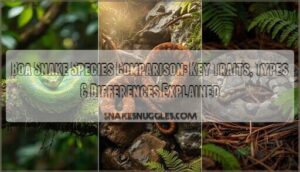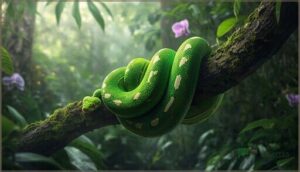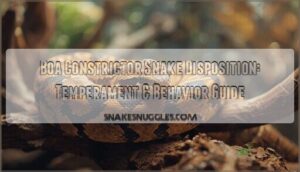This site is supported by our readers. We may earn a commission, at no cost to you, if you purchase through links.
When you spot a thick-bodied snake coiled in the underbrush, you might assume all boas are cut from the same cloth—but that couldn’t be further from the truth. The boa family spans an astonishing range of sizes, from the two-foot rubber boa tucked into Pacific Northwest forests to the thirteen-foot giants prowling South American jungles.
These constrictors have evolved distinct hunting strategies, temperature tolerances, and even anatomical features that set them apart from their cousins and from other snake families entirely.
Understanding what separates a red-tailed boa from an emerald tree boa, or why island species developed traits found nowhere else, gives you the tools to identify, appreciate, and properly care for these extraordinary reptiles.
Table Of Contents
Key Takeaways
- Boa species range dramatically in size from the two-foot rubber boa to thirteen-foot giants, with each species evolving distinct hunting strategies, temperature tolerances, and anatomical features like heat-sensing pits that set them apart from other snake families.
- Physical identification relies on unique traits such as pelvic spurs (tiny limb remnants), two working lungs instead of one, and species-specific scale patterns, while behavioral differences include varied activity cycles, defensive tactics, and specialized hunting methods from arboreal ambush to ground-dwelling stealth.
- Geographic distribution spans from Mexico to Argentina for boa constrictors, with specialized adaptations allowing emerald tree boas to thrive in rainforest canopies using prehensile tails while rosy boas dominate southwestern deserts through thermal regulation in rocky crevices.
- Conservation challenges threaten multiple species—the Jamaican boa has lost 91% of its range, the Argentine boa faces habitat destruction from agriculture, and the Puerto Rican boa recovered to 30,000 individuals through targeted wildlife preservation, demonstrating that intervention works when communities commit to protection.
Key Characteristics of Boa Snake Species
Every boa species has its own signature look and set of behaviors, shaped by where it lives and how it survives. Some traits are easy to spot from a distance, while others show up only with a closer look.
Here’s what to pay attention to when comparing their most important features.
Physical Traits and Morphology
Physical characteristics of boas are a study in contrasts. From the tiny rubber boa, rarely topping 1.3 pounds, to the massive boa constrictor, size variation is striking. You’ll notice sexual dimorphism, with females usually larger. One example of this is how the females are larger.
Intricate scale patterns create species-specific camouflage, while unique sensory adaptations—like heat-sensing pits—make boas masters of their environments. Ontogenetic changes shift snouts and hues with age.
Behavioral Differences
Beyond appearances, activity patterns and feeding habits set boa snakes apart. Some, like the boa constrictor, ambush at night, rarely socializing except during mating—think brief, tense encounters. Defensive tactics range from hissing or coiling to camouflage.
Animal Behavior Studies reveal that coordinated hunting, reproductive behaviors, and how boas handle threats all shape the fascinating spectrum of snake behavior and conservation needs. These snakes exhibit diurnal active foraging behaviors.
Distinguishing Boas From Other Snakes
If you’re curious about snake identification, a closer look at boa anatomy tells the story. Unlike most snakes, boas keep two working lungs and boast pelvic spurs—tiny limb remnants. Their constrictor methods are direct, with no venom glands or hollow fangs.
Recognizing different boa species often comes down to scale patterns, unique to boa constrictor species within this ancient family of snake classification.
Major Boa Species Around The World
If you’ve ever wondered just how many types of boas are out there, you’re about to find out. These snakes live in places as different as rainforests, deserts, and even remote islands.
Let’s take a closer look at some of the most fascinating boa species from around the globe.
Boa Constrictor (Boa Constrictor)
Ever wonder how such a powerful ambush predator carves out space from Mexico to Argentina? The boa constrictor shows off striking sexual dimorphism, with females growing up to 10 feet.
Its mastery of both arboreal behavior and ground-dwelling stealth allows impressive prey selection.
With proper care, captive lifespan can reach three decades—truly exceptional among snakes.
Emerald Tree Boa (Corallus Caninus)
Emerald Tree Boa stands out among boa species for its dazzling snake coloration and textbook arboreal adaptations. In a rainforest habitat, you’ll spot their nocturnal behavior and signature coiled posture. If you’re brushing up on boa snake identification, remember these five highlights:
- Bright green body
- White zigzag markings
- Prehensile tail
- Razor-sharp constriction techniques
- Stable conservation status
Rosy Boa (Lichanura Trivirgata)
Rosy Boa (Lichanura trivirgata) thrives in southwestern deserts, showcasing three bold stripes—brown, orange, or red-brown—on a lighter background for effective snake identification. You’ll find these arid adaptations in rocky hillsides and chaparral, where their calm temperament makes captive care straightforward.
Rosy morphs display stunning coloration variations, but conservation threats from pet trade collection have made the species “sensitive” in California, highlighting important desert ecology concerns.
Rubber Boa (Charina Bottae)
The Rubber Boa (Charina bottae) stands out among boa species for its remarkably docile behavior and unique rubber-like skin texture. You’ll find this gentle constrictor in western North America, where dwarf populations inhabit isolated mountain ranges.
Understanding rubber boa reptile biology reveals viviparous birth patterns and habitat loss concerns affecting its 12–25-year lifespan range, making it essential for herpetology research.
Island and Endemic Boa Species
Island evolution has sculpted some of the most fascinating boa species, where genetic isolation sparked unique adaptations you won’t find anywhere else. The Virgin Island tree boa reaches just two feet in length, while the Round Island keel-scaled boa possesses a remarkable jaw joint found in no other terrestrial vertebrate.
Island isolation has driven boas to evolve extraordinary adaptations found nowhere else on Earth
Conservation challenges mount as habitat loss and invasive predators threaten these endemic populations.
Comparing Boa Constrictor Subspecies
When you look at the boa constrictor species, you’ll find it’s not just one snake but a family of ten distinct subspecies, each shaped by its own corner of the Americas.
These subspecies differ dramatically in size, coloration, and behavior, reflecting the varied landscapes they call home.
Let’s examine five of the most recognized subspecies and what sets each one apart.
Red-Tailed Boa (B. C. Constrictor)
Among boa constrictor subspecies, the Red-Tailed Boa (Boa constrictor constrictor) stands out with its signature reddish-brown saddle pattern against tan or cream backgrounds.
Females generally reach 7 to 10 feet, while males measure 6 to 8 feet. These snakes reach sexual maturity between 2.5 and 4.5 years, with females producing litters of 10 to 65 neonates depending on their size and health.
Northern Boa (B. C. Imperator)
The Northern Boa (Boa constrictor imperator) brings a slender build and adaptable temperament to its northern habitat across Mexico and Central America. Adults average 5 to 7 feet, with some populations showing natural dwarfism.
This boa subspecies displays considerable color variation—from hypo- to hyper-melanistic morphs—making boa imperator care popular among enthusiasts who appreciate its manageable size and diverse boa morphology.
Argentine Boa (B. C. Occidentalis)
The Argentine Boa (Boa constrictor occidentalis) stands apart as one of the largest boa constrictor subspecies, exceeding 10 feet with a sturdy frame. Unfortunately, habitat loss has claimed a third of its original range, sparking urgent conservation status concerns:
- Adult length surpasses 10 feet
- Reduced to 30 million hectares
- CITES Appendix I protection active
- Agricultural expansion threatens survival
Tumbes Peru Boa (B. C. Longicauda)
Native to northern Peru’s Tumbes province, the Boa constrictor longicauda rarely exceeds 6 feet yet captivates with sharp black-and-white or black-and-gold coloration that intensifies with age. You’ll spot an arrowhead marking between the eyes—a signature trait among boa constrictor subspecies. Various color morphs exist within this unique boa snake species, though conservation status and habitat threats warrant careful monitoring for this distinctive Tumbes Peru boa constrictor.
| Feature | Detail | Significance |
|---|---|---|
| Adult Length | Up to 6 feet | Among smallest boa subspecies |
| Coloration | Black/white or black/gold contrast | Increases with maturity |
| Head Marking | Arrowhead between eyes | Key identification trait |
Mexican Boa (B. C. Sigma)
Captive breeding programs have revealed the Mexican boa constrictor’s dramatic size variations—adults often measure under 38 inches, making Boa constrictor sigma one of the smallest boa constrictor subspecies. Their impressive temperature tolerance sets them apart within boa constrictor classification, though conservation needs remain under review.
You’ll notice juveniles display striking unique markings: sharply defined black blotches against beige backgrounds with a pronounced head spear, sometimes tinged pink between saddles.
- Adults rarely exceed 38 inches in captive-bred lines
- Juveniles feature sharp black patterns on light beige backgrounds
- Temperature tolerance distinguishes them from other boa constrictors
Habitat, Distribution, and Ecological Adaptations
Understanding where boas live and how they’ve adapted to their environments reveals just how fascinating these snakes truly are. From rainforest canopies to desert floors, different species have claimed territories across multiple continents, each developing specialized traits for survival.
Let’s explore the geographic distribution, habitat preferences, and ecological niches that define boa species around the world.
Geographic Range by Species
Boa species sprawl across remarkably diverse territories, from Mexico’s scrublands to Argentina’s grasslands. Boa constrictors dominate South America and Central America, while emerald tree boas are exclusive to the Amazon rainforests. Rosy boas inhabit southwestern deserts, and rubber boas prefer the northwestern forests. Island endemics, such as Madagascar’s Dumeril’s boa, showcase the creativity of evolution. Introduced populations now thrive in Florida, demonstrating these snakes’ adaptability beyond their native range.
| Species | Geographic Distribution | Habitat Overlap |
|---|---|---|
| Boa Constrictor | Mexico to Argentina, Caribbean islands | Extensive across vegetation types |
| Emerald Tree Boa | Amazon basin, northern South America | Minimal, rainforest-specific |
| Rosy Boa | Southwestern U.S., northwestern Mexico | Limited to arid regions |
Habitat Preferences and Adaptations
How do snakes with such different bodies thrive in vastly different habitats? The answer lies in exceptional ecological adaptation. Emerald tree boas use arboreal adaptations like prehensile tails for canopy life, while rosy boas prefer terrestrial habitats with rocky crevices for temperature regulation.
Boa constrictor habitats vary widely:
- Dense vegetation for ambush hunting
- Water sources for hydration needs
- Microhabitat selection based on thermal requirements
- Shelters protecting against habitat disturbance
Understanding snake habitat needs aids reptile conservation efforts.
Niche Specialization Among Boas
When multiple boa species share the same region, they’ve evolved striking ways to coexist without direct competition. Prey partitioning is at work—emerald tree boas hunt birds in the canopy while boa constrictors target ground mammals.
Habitat segregation further reduces overlap, with rosy boas occupying rocky microhabitats and rubber boas exploiting underground burrows. This adaptive radiation demonstrates how ecological niche specialization drives species coexistence in herpetology.
Conservation Status and Unique Features
Not all boa species are thriving in the wild—some face extinction while others flourish across their native ranges. Understanding which species need protection and what makes each one unique helps you appreciate the conservation challenges these constrictors face today.
Beyond survival status, boas display striking physical diversity, from subtle earth tones to vibrant pattern morphs that captivate collectors and researchers alike.
Endangered and Threatened Boa Species
Several boa constrictor species face serious threats, and understanding their conservation status helps protect these notable snakes. Habitat destruction and invasive predators have pushed multiple populations toward extinction, while climate impacts reduce suitable ranges for temperature-sensitive species.
Key endangered species include:
- Puerto Rican boa: Once critically imperiled, now rebounding with approximately 30,000 individuals through wildlife preservation efforts
- Jamaican boa: Listed as Vulnerable, occupying just 9% of Jamaica’s land area due to habitat fragmentation
- Argentine boa: Critically endangered, requiring immediate snake conservation action
Population monitoring and conservation successes demonstrate that targeted interventions work when communities commit to protecting these constrictors.
Color Variations and Morphs
Selective morph breeding has transformed the boa constrictor hobby, with over 90% of commercial boas tracing back to controlled genetic programs. You’ll find albino morphs lacking melanin, anerythristic types showing only blue and gray, and patterned varieties like Motley and Aztec starting around $100.
Rare color mutations such as Moon Glow command $1,000-plus, showcasing the striking pattern variation captive breeding unlocks across subspecies.
Conservation Efforts and Human Impact
Habitat destruction and human encroachment now threaten even common boa populations—over 91% of the Jamaican boa’s range has vanished. You’ll find illegal trade targeting red sand boas across 18 Indian states, while protected areas and reintroduction programs offer hope.
Conservation of snake species demands captive breeding efforts, wildlife preservation initiatives, and combating wildlife trade to counteract ongoing habitat degradation threatening these striking constrictors.
Frequently Asked Questions (FAQs)
How long do boa snakes typically live?
Regarding boa longevity, these resilient constrictors can clock anywhere from 20 to 30 years in captivity, with rare individuals occasionally surpassing the 40-year mark under ideal care conditions.
What do baby boas eat after birth?
Baby boas eat pinkie mice shortly after birth, usually within their first week.
These independent neonates rely on their vomeronasal system to detect prey, feeding every 7–14 days to minimize regurgitation risk.
Can different boa species breed with each other?
Different boa species can’t successfully interbreed despite genetic testing attempts. Reproductive barriers from evolutionary divergence prevent viable hybrid offspring. Subspecies within Boa constrictor show better genetic compatibility, though conservation risks discourage such interbreeding practices in taxonomy studies.
How often do boas shed their skin?
You’d think shedding frequency would be universal, but boa species defy expectations—juvenile boas molt every 3-4 weeks during rapid growth, while adults shed 2-4 times yearly depending on humidity effects and ecdysis patterns.
Are boa snakes dangerous to humans?
Boa species, including boa constrictors, are nonvenomous and pose minimal risk to humans.
These snakes rarely attack people, with fewer than 5% showing aggression during handling and fatalities remaining exceptionally rare worldwide.
Conclusion
You could spend years studying every boa snake species comparison and still discover new surprises—each species represents millions of years of evolutionary fine-tuning.
From the rubber boa’s snow-dusted territories to the emerald tree boa’s canopy domain, these constrictors prove that nature rarely repeats itself.
Armed with the traits, ranges, and adaptations outlined here, you’re now equipped to distinguish any boa you encounter, whether in the wild, a collection, or conservation documentation.















